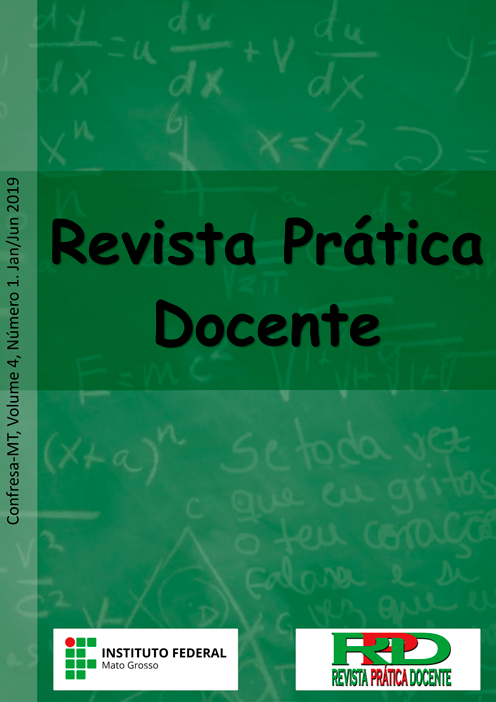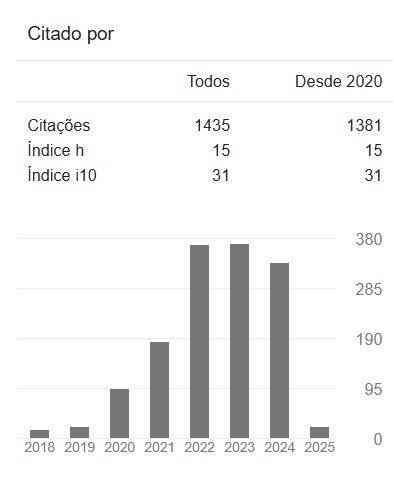REASONS FOR A SEMIOTIC APPROACH TO MATHEMATICS EDUCATION
DOI:
10.23926/RPD.2526-2149.2019.v4.n1.p24-41.id350Keywords:
Mathematical Education, Philosophy of Mathematics, Semiotics, MathematicsAbstract
Only recently has the semiotic approach become more acceptable or common in mathematics education research and analysis and has gradually disconcerted the Platonic foundation of mathematical objects. In fact it has become increasingly evident that the meanings of concepts develop in the social relationships. The objective is to present the reasons for the use of the semiotic approach in mathematical education. We are arguing, in fact, that the crystallization of mathematical concepts limits creativity and distances school learning from the day to day practices. In theoretical research, questions are addressed such as What is the x in this equation?, evidencing a part of the work of Frege and Benacerraf, with more appreciation to the Peirce’s Semiotic. Illustrative and important examples of such a perspective are presented. For example, the complementarity between text and diagram offers opportunities of critical reflections about the expected results of education in mathematics. Therefore, to think semiotically is to recognize that all knowledge is dynamic, despite being constructed through signs, implying responsibilities, either in choosing the strategy defined for each problem situation, or in identifying the meanings according to the given references and the interactions with the world.
Downloads
Metrics
References
ABBAGNANO, Nicola. Dicionário de Filosofia. 5ªed. São Paulo: Martins Fontes, 2007.
ANDERY, Maria Amália et al. Para compreender a Ciência: uma perspectiva histórica. Rio de Janeiro: Editora Garamond, 2014.
BENACERRAF, Paul. What Numbers could not be; reprinted 1985 in: Benacerraf/ Putnam (eds), Philosophy of Mathematics, Cambridge University Press, London, 1965. DOI: https://doi.org/10.1017/CBO9781139171519.015
BERKELEY, George. 1710/1957. A treatise concerning the principles of human knowledge. Indianapolis, IN: Bobbs-Merrill, 1710.
BOHM, David Joseph. Science as Perception Communication, in: F Suppe (Ed), The Structure of Scientific Theories, Urbana: University of Illinois Press, 374-423, p. 383f), 1977.
CHIHARA, Charles. A Structural Account of Mathematics. Oxford: Clarendon Press, 2004.
CORRÊA, Isabella Moreira de Paiva. Como se fala matemática? Um estudo sobre a complementaridade entre representação e comunicação na educação matemática. 2008. 154f. Dissertação (Mestrado em Educação) - Universidade Federal de Mato Grosso, Cuiabá, 2008.
CORRÊA, Isabella Moreira de Paiva. Como se fala matemática? Um estudo sobre a complementaridade entre representação e comunicação na educação matemática. 2008. 154f. Dissertação (Mestrado em Educação) - Universidade Federal de Mato Grosso, Cuiabá, 2008.
EUCLIDES. Os Elementos. Tradução de Irineu Bicudo. Rio Claro: Unesp, 2009.
FEYNMAN, Richard. The Character of Physical Law. Cambridge: MIT Press, 1967.
FONSECA, Rogério Ferreira da. A Complementaridade entre os Aspectos Intensional e Extensional na Conceituação de Número Real Proposta por John Horton Conway. 2010. 182 f. Tese (Doutorado em Educação Matemática) - Pontifícia Universidade Católica de São Paulo, São Paulo, 2010.
FREGE, Gottlob. Die Grundlagen der Arithmetik, Breslau, 1884.
FREGE, Gottlob. Ñber Sinn und Bedeutung, Zeitschrift für Philosophie und philosophische Kritik NF 100, 25–50, 1892.
FREGE, Gottlob. Illustrative extracts from Frege’s review of Husserl’s Philosophie der Arithmetik I. In: Translations from the Philosophical Writings of Gottlob Frege. Ed. by Peter Geach and Max Black. Oxford: Blackwell, p. 79-85, 1952.
HEIJENOORT, Jean Van. Logic as Calculus and Logic as Language. Synthese. New York: Springer, v. 17, p. 324-330. 1967. DOI: https://doi.org/10.1007/BF00485036
HILBERT, David. Mathematical Problems: Lecture delivered before the International Congress of Mathematicians at Paris in 1900. Disponível em: <https://mathcs.clarku.edu/~djoyce/hilbert/problems.html>. Acessado em: 02 jul. 2018.
KANT, Immanuel. Critique of Pure Reason. Translated and edited by Paul Guyer and Allen W. Wood. Cambridge: Cambridge University Press, 1998. DOI: https://doi.org/10.1017/CBO9780511804649
LEIBNIZ, Gottfriend Wilhelm. Nouveaux Essais sur l’Entendement Humain. Paris: Editions Flamarion. 1993.
LOCKE, John. An Essay Concerning Human Understanding. New York: Oxford University Press, 1690 (1975). DOI: https://doi.org/10.1093/oseo/instance.00018020
MANNHEIM, Karl. Ideologie und Utopie. Frankfurt, 1929.
MARX, Karl. Capital: A Critique of Political Economy. Vl. 1. New York, NY: International Publishers, 1967.
MCGINN, Colin. Logical Properties. Oxford: Claredon Press, 2000. DOI: https://doi.org/10.1093/0199241813.001.0001
NASCIMENTO, Demilson Benedito. Hermann Günter Grassmann (1809-1877) e o Desenvolvimento do Pensamento Geométrico: A Complementaridade Entre Alguns Aspectos da Die Lineale Audehnungslehre (1844). 2013. 189 f. Tese (Doutorado em Educação) - Universidade Federal de Mato Grosso, Cuiabá, 2013.
OTTE, Michael Friedrich. Analysis and Synthesis in Mathematics from the Perspective of Charles S. Peirce`s Philosophy. In: Otte, M./M. Panza (eds.), Analysis and Synthesis in Mathematics: History and Philosophy. Boston Studies in the Phil. Of Science, vol. 196, Kluwer, 327-364, 1997. DOI: https://doi.org/10.1007/978-94-011-3977-9_13
OTTE, Michael Friedrich. Proof analysis and Continuity, Foundations of Science, vol. 11, p. 121–155, 2006. DOI: https://doi.org/10.1007/s10699-004-5915-0
OTTE, Michael Friedrich. A Realidade das Ideias: uma perspectiva epistemológica para a Educação Matemática. Cuiabá, MT, Editora da UFMT, 2012.
OTTE, Michael Friedrich.; BARROS, Luiz Gonzaga Xavier de. Creativity, Tacit Knowledge and Mathematics Education. Caminhos da Educação Matemática em Revista, On line - v. 3, n. 1, p. 101-111, 2015. Disponível em: <https://aplicacoes.ifs.edu.br/periodicos/index.php/caminhos_da_educacao_matematica/article/view/46/31 >. Acessado em: 19 dez. 2018
PEIRCE, Charles Sanders.: CP = Collected Papers of Charles Sanders Peirce. Vol. I-VI, ed. by Charles Hartshorne and Paul Weiß, Cambridge, Mass. (Harvard UP) 1931-1935, Vol. VII-VIII, ed. by Arthur W. Burks, Cambridge, Mass. (Harvard UP), 1958, (quoted by no. of volume and paragraph).
SANTAELLA, Lucia. O que é semiótica? São Paulo: Abril Cultural, 2007.
SILVA, Fernanda Ivo da. O pensamento relacional na geometria computadorizada. 2009. 122f Dissertação (Mestrado em Educação) — Universidade Federal de Mato Grosso, Cuiabá, 2009.
WIELEWSKI, Gladys Denise. O tabuleiro de xadrez: Uma perspectiva para a didática da Aritmética. 1998. 230f. Dissertação (Mestrado em Educação) – Universidade Federal de Mato Grosso, Mato Grosso, Cuiabá, 1998.
Downloads
Published
How to Cite
Issue
Section
License
Copyright (c) 2023 A Revista Prática Docente tem o direito de primeira publicação

This work is licensed under a Creative Commons Attribution-NonCommercial 4.0 International License.
Authors who publish in this journal agree to the following terms:
- Authors retain the copyright and grant the journal the right of first publication, with the paper simultaneously licensed under the Licença Creative Commons Attribution allows the sharing of the work with acknowledgment of authorship and initial publication in this journal.
- Authors are authorized to take additional contracts separately, for non-exclusive distribution of the version of the work published in this journal (e.g. publish in institutional repository or as a book chapter), with acknowledgment of authorship and initial publication in this journal.











